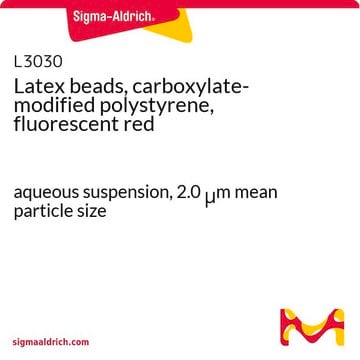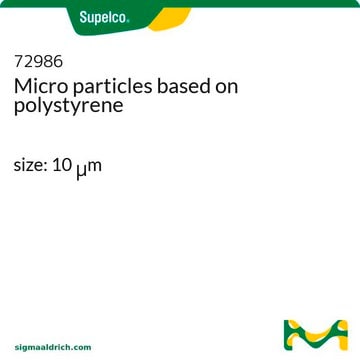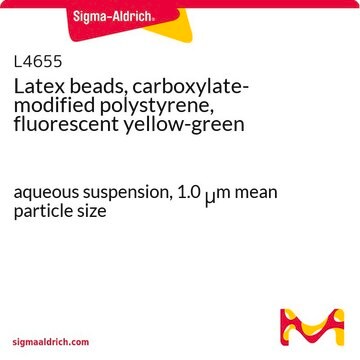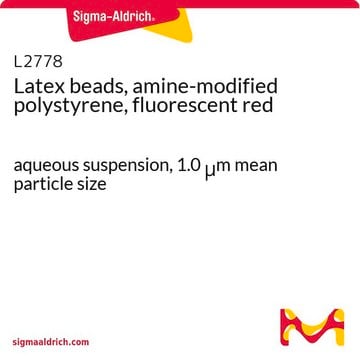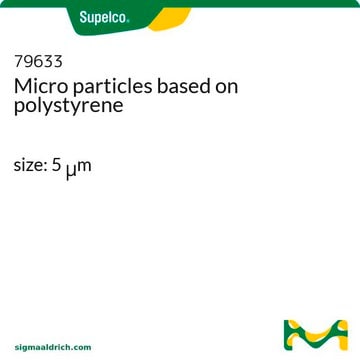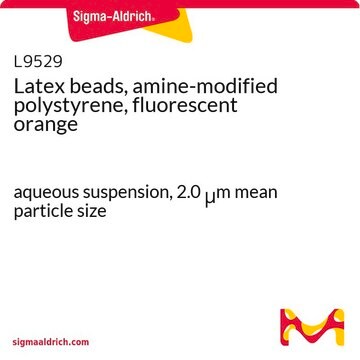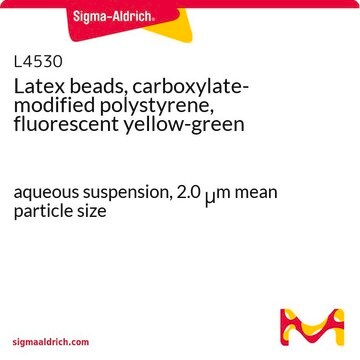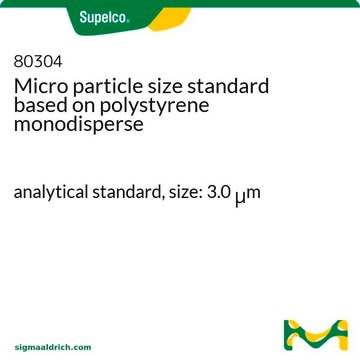LB30
Latex beads, polystyrene
3.0 μm mean particle size
Synonym(s):
Latex Beads, Latex Microspheres
Sign Into View Organizational & Contract Pricing
All Photos(1)
About This Item
Recommended Products
form
aqueous suspension
composition
Solids, 10%
packaging
pack of 1 mL
pack of 15 mL
pack of 2 mL
mean particle size
3.0 μm
Looking for similar products? Visit Product Comparison Guide
General description
Latex beads are utilized in applications including electron microscopy and cell counter calibration, antibody-mediated agglutination diagnostics, phagocytosis experiments, and many others. The most popular use of latex beads is, particularly in latex agglutination tests. This method allows the detection of minute amounts of antigens or antibodies in serum, urine, and cerebrospinal fluids. It is also used in phagocytosis research. The beads are supplied as aqueous suspensions and are composed mainly of polymer particles (30%) and water, (>69.0%) with small amounts of surfactant, (0.1–0.5%) sodium bicarbonate, and potassium sulfate (inorganic salts – 0.2%). This product is for R&D use only, not for drug, household, or other uses. For more information, please refer the Product Information Sheet.
Storage Class Code
12 - Non Combustible Liquids
WGK
WGK 3
Flash Point(F)
Not applicable
Flash Point(C)
Not applicable
Certificates of Analysis (COA)
Search for Certificates of Analysis (COA) by entering the products Lot/Batch Number. Lot and Batch Numbers can be found on a product’s label following the words ‘Lot’ or ‘Batch’.
Already Own This Product?
Find documentation for the products that you have recently purchased in the Document Library.
Customers Also Viewed
Silène T Wavre-Shapton et al.
Human molecular genetics, 24(24), 7060-7074 (2015-10-10)
Retinal degeneration and visual impairment are the first signs of juvenile neuronal ceroid lipofuscinosis caused by CLN3 mutations, followed by inevitable progression to blindness. We investigated retinal degeneration in Cln3(Δex1-6) null mice, revealing classic 'fingerprint' lysosomal storage in the retinal
Agustín Mangiarotti et al.
Langmuir : the ACS journal of surfaces and colloids, 35(30), 9848-9857 (2019-07-04)
Hopanoids are pentacyclic molecules present in membranes from some bacteria, recently proposed as sterol surrogates in these organisms. Diplopterol is an abundant hopanoid that, similar to sterols, does not self-aggregate in lamellar structures when pure, but forms monolayers at the
Mona Seifert et al.
Nucleic acids research, 48(10), 5591-5602 (2020-04-15)
RNA virus survival depends on efficient viral genome replication, which is performed by the viral RNA dependent RNA polymerase (RdRp). The recent development of high throughput magnetic tweezers has enabled the simultaneous observation of dozens of viral RdRp elongation traces
Ming Gao et al.
Transfusion, 58(10), 2388-2394 (2018-09-12)
Although platelet microparticles (PMPs) were the most abundant micoparticles (MPs) in platelet (PLT) products, other MPs and their parental cells can also be brought into the plasma during PLT apheresis. However, the effects of PLT apheresis, storage time, and leukofiltration
Nichaluk Leartprapun et al.
Nature communications, 9(1), 2079-2079 (2018-05-29)
Optical tweezers are an invaluable tool for non-contact trapping and micro-manipulation, but their ability to facilitate high-throughput volumetric microrheology of biological samples for mechanobiology research is limited by the precise alignment associated with the excitation and detection of individual bead
Our team of scientists has experience in all areas of research including Life Science, Material Science, Chemical Synthesis, Chromatography, Analytical and many others.
Contact Technical Service
